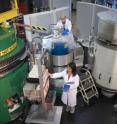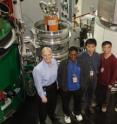New iron-based and copper-oxide high-temperature
In the initial studies of a new class of high-temperature superconductors discovered earlier this year, research at the Commerce Department’s National Institute of Standards and Technology (NIST) has revealed that new iron-based superconductors share similar unusual magnetic properties with previously known superconducting copper-oxide materials. The research appears in the May 28 Advanced Online Publication of the journal Nature. These superconductors may one day enable energy and environmental gains because they could significantly heighten the efficiency of transferring electricity over the electric grid or storing electricity in off-peak hours for later use.
“While we still do not understand how magnetism and superconductivity are related in copper-oxide superconductors,” explains NIST Fellow Jeffrey Lynn at the NIST Center for Neutron Research (NCNR), “our measurements show that the new iron-based materials share what seems to be a critical interplay between magnetism and superconductivity.”
The importance of magnetism to high-temperature superconductors is remarkable because magnetism strongly interferes with conventional low-temperature superconductors. “Only a few magnetic impurities in the low-temperature superconductors sap the superconducting properties away,” says Lynn.
By contrast, copper-oxide superconductors, discovered in 1986, tolerate higher magnetic fields at higher temperatures. The highest performance copper-oxide superconductors conduct electricity without resistance when cooled to "transition temperatures" below 140 Kelvin (-133 Celsius) and can simply and cheaply be cooled by liquid nitrogen to 77 Kelvin or (-196 Celsius).
Japanese researchers discovered earlier this year that a new class of iron-based superconducting materials also had much higher transition temperatures than the conventional low-temperature superconductors. The discovery sent physicists and materials scientists into a renewed frenzy of activity reminiscent of the excitement brought on by the discovery of the first high-temperature superconductors over 20 years ago.
Earlier work on the copper-oxide superconductors revealed that they consist of magnetically active copper-oxygen layers, separated by layers of non-magnetic materials. By “doping,” or adding different elements to the non-magnetic layers of this normally insulating material, researchers can manipulate the magnetism to achieve electrical conduction and then superconductivity.
The group of scientists studying the iron-based superconductors used the NCNR, a facility that uses intense beams of neutral particles called neutrons to probe the atomic and magnetic structure of the new material.
As neutrons probed the iron-based sample supplied by materials scientists in Beijing, they revealed a magnetism that is similar to that found in copper-oxide superconductors, that is, layers of magnetic moments—like many individual bar magnets—interspersed with layers of nonmagnetic material. Lynn notes that the layered atomic structure of the iron-based systems, like the copper-oxide materials, makes it unlikely that these similarities are an accident.
One of the exciting aspects of these new superconductors is that they belong to a comprehensive class of materials where many chemical substitutions are possible. This versatility is already opening up new research avenues to understand the origin of the superconductivity, and should also enable the superconducting properties to be tailored for commercial technologies.
Source: National Institute of Standards and Technology (NIST)
Articles on the same topic
- New superconductors present new mysteries, possibilitiesWed, 4 Jun 2008, 19:21:49 UTC
- Magnet lab research suggests novel superconductorWed, 28 May 2008, 19:21:37 UTC
- Getting warmer: UT Knoxville researchers uncover information on new superconductorsWed, 28 May 2008, 17:28:51 UTC
Other sources
- New Superconductors Present New Mysteries, Possibilitiesfrom Science DailyThu, 5 Jun 2008, 0:35:40 UTC
- New Superconductors Present New Mysteries, Possibilitiesfrom Newswise - ScinewsWed, 4 Jun 2008, 20:28:15 UTC
- New superconductors present new mysteries, possibilitiesfrom PhysorgWed, 4 Jun 2008, 20:07:39 UTC
- Study might lead to novel superconductorsfrom UPIMon, 2 Jun 2008, 16:21:25 UTC
- New High-Temperature Superconductors Are Iron-based With Unusual Magnetic Propertiesfrom Science DailySun, 1 Jun 2008, 4:21:16 UTC
- Magnet Lab Research Suggests Novel Superconductorfrom Science DailyThu, 29 May 2008, 14:14:22 UTC
- Powerful Superconductor in a Class All Its Ownfrom Newswise - ScinewsWed, 28 May 2008, 20:28:15 UTC
- New Iron-based and Copper-Oxide High-Temperature Superconductors Share Key Magnetic Propertiesfrom PhysorgWed, 28 May 2008, 17:49:09 UTC
- New Iron-based and Copper-Oxide High Temperature Superconductors Share Key Magnetic Propertiesfrom Newswise - ScinewsWed, 28 May 2008, 17:28:15 UTC

